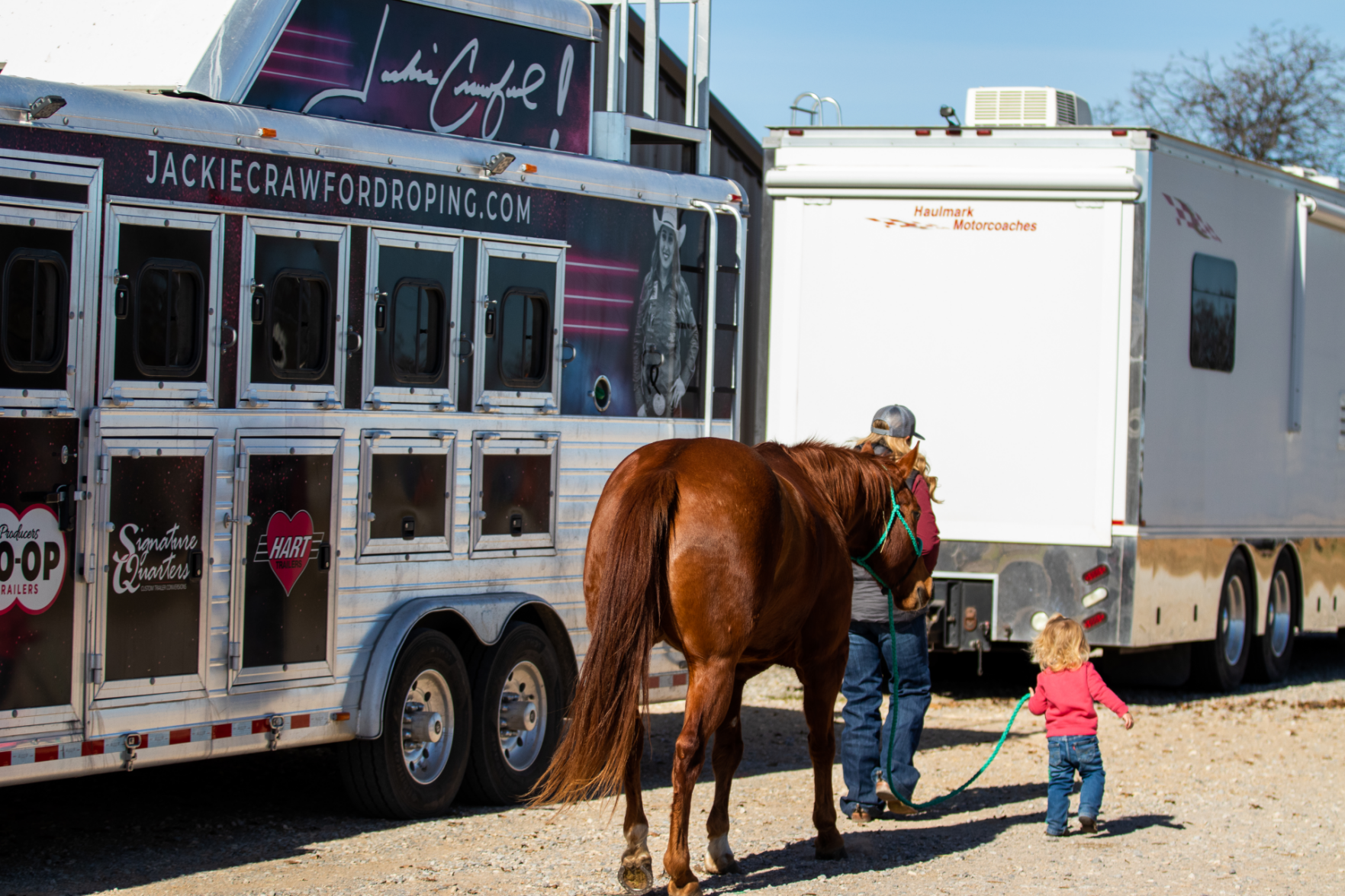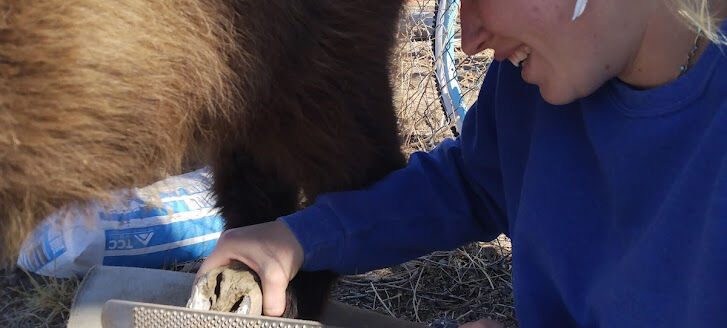Thousands of miles of dotted lines have passed before the view of World Champion Breakaway Roper, Jackie Crawford, while hauling some of the world’s greatest.
She, along with Dr. Steve Allday, DVM—a competitive team roper and equine lameness specialist overseeing the care of legendary Thoroughbred racehorses, including two Triple Crown Winners—share best practices for safer hauling and joint health assurance for horses.
Joint health
Joint health while hauling—what are best practices?
“We ask so much of our horses, not only in competition but even just going down the road,” Crawford says. “They take so much percussion on their joints in the trailer alone—that part worries me even more so than what we’re asking them to do in the arena sometimes. We do everything we can, preventatively.”
Prevention is key.
“The pressure of shipping and traveling—and the pounding and grinding from shipping and training and performing—all these things add up,” says Allday, who also developed LubriSyn HA. Prevention and trusted supplements are “paramount to maintaining the health of the joint on a regular basis,” he said.
Crawford does everything she can, preventatively, with supplements and other considerations when they’re at an event, especially during the summer with even more frequent haulings. She stresses the importance to consider “even the little things,” like where horses are stalled and getting them access to turnout.
“It’s really hard to try to find good places for those horses to stay and be able to rest their joints and relax. It’s important to find good places to turn them out and let them roll,” Crawford says. “Paying for the preventative measures is so much better than trying to pay to fix something once it’s gone bad. I’m going to do everything I can, short of bubble wrapping these horses, to try to keep them going up and down the road and keep us winning.”
Allday’s credo is to choose preventative medicine over restorative.
“Trying to stay ahead of it on the preventative side is always the smarter move if you’re trying to keep an athlete out on the road. The bottom line is, if you can prevent something from happening, you’re going to have better results. Restorative medicine essentially means you’re fixing, or attempting to fix, an existing problem at that point and with the approach of restorative medicine, your horse is not going to regain full function, at least not right away,” explains Allday.
Pit stops
“I like to get horses off the trailer at least every six hours,” says Crawford. “We don’t just necessarily get them off and walk them around; I really want those horses to get to rest for the time that they’re off the trailer.”
When at all possible, plan ahead to identify safe and secure areas to unload. And if an overnight is required, research stables beforehand to reserve a space. If your horse is selective about their water source away from home, haul water with you if possible, along with their regular grain and hay to keep them consistent.
“Also, I think it’s very important for a horse to get his head down when you get them off the trailer,” says Crawford. “It’s really, really important for a couple reasons. It stretches their back muscles, and it helps to drain any fluid that they have caught up.”
Crawford recalled two horses being hauled by a shipper and they were not given the opportunity to stretch their heads down, instead they were walked, watered, and tied back up. “For a lot of hours, those horses never drained. We came back home, and two of them ended up in the vet clinic with tubes coming out of their chest with pneumonia. It was the craziest thing, and honestly until that point, I had not thought about it either.”
To encourage horses to put their head down, she waters them on the ground, grazes them, or puts hay on the ground for them to graze.
Allday explained more.
“As you go down the road, there are a lot of dust particles, hay and things that float around in the trailer that horses inspire. It then gets into their upper respiratory tract and down into their bronchial tree. When horses get out [of the trailer] and they put their head down in the water as they rehydrate, it basically stimulates the clearance mechanism, and the fluid on the top of the Celia, down the trachea, helps things move up out of the bronchial tree and the lower tree. This helps the horse expectorate and move things out of their airways,” shared Allday.
House keeping
Crawford is careful to clean out the ammonia from the trailer with her frequent stops, saying, “I don’t want them breathing it in.”
Allday said this is an excellent suggestion because, “Ammonia is very irritating in the airway of both people and horses. Getting that cleared out is an excellent suggestion, especially during the wintertime, because we tend to seal the trailers up.”
Airflow
Keep windows open to offer horses a nice breeze.
“I like good circulation and ventilation in a trailer, winter or summer,” says Allday. “Having good air circulating and removing anything that would build up a lot of the ammonia, in particular, is important.”
Clean air is key, as is keeping airflow from preventing a hot trailer.
“If you have a four-horse trailer with four horses in there, they generate an unbelievable amount of heat,” warns Allday. “Even in regular temperatures, let’s say 72 degrees, four horses require a tremendous amount of air circulation to keep heat from building up inside. During the period of an hour, you can raise the temperature in a trailer by as much as 20 to 30 degrees.”
Protection
For added protection of their eyes and legs, “We haul our horses with fly masks, so that if anything blows, it doesn’t get in their eyes, and we use shipping boots. What I tend to do in the summertime is to use mud or liniment on the legs to help cool the horse,” shares Crawford. She specified that in the summer, she uses the mud or liniment by itself, and in the winter months, she’ll apply underneath of shipping boots.
Be sure to keep these tips in mind when you and your horses hit the road next.
“These are all really great ideas that Jackie has given you. You’re getting a lesson from a person who has been down the road at least hundreds of thousands of miles,” said Allday.
In parting comments, asked about the resurgence of breakaway roping and what it means to her, Crawford didn’t balk: “When I started doing this, it was unheard of for a woman to make a living with a rope, and now I think it’s actually possible for a lot of girls, if that’s what’s in their heart, and that’s their passion and their drive. They always say that, ‘If you do what you love, you’ll never work a day in your life.’ And I truly feel like that. I work my butt off, but guess what? I love it. It’s so fun, and I think that so many other girls are going to get to experience that.”




